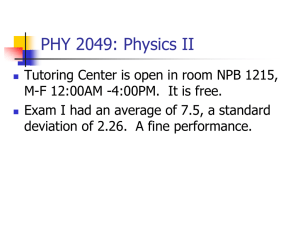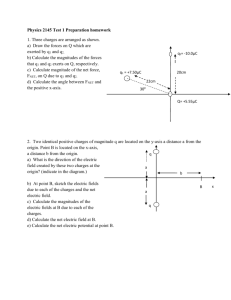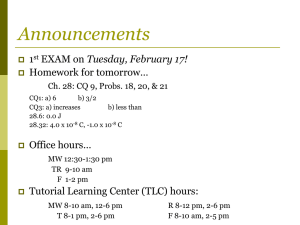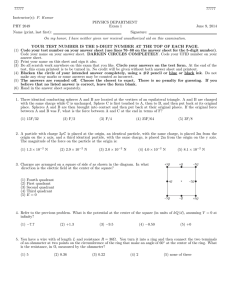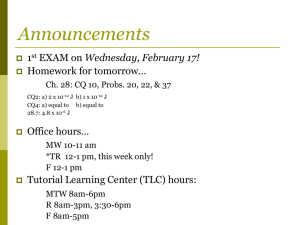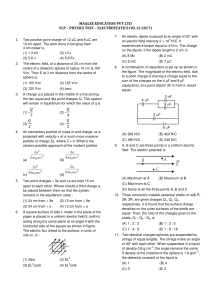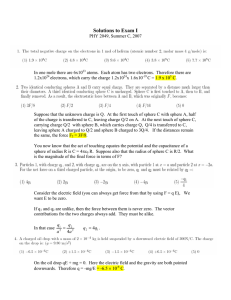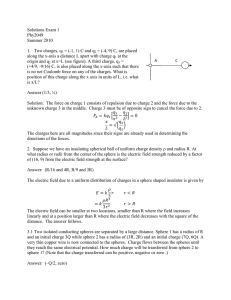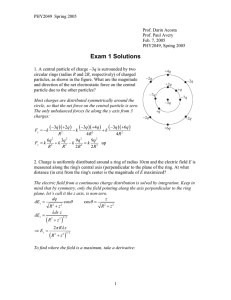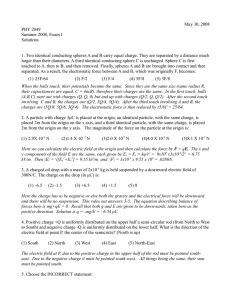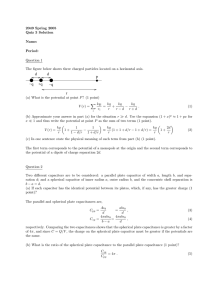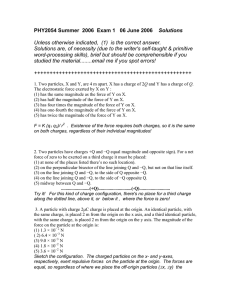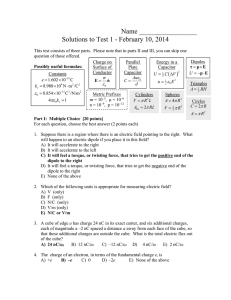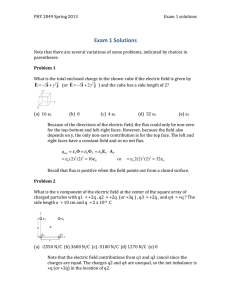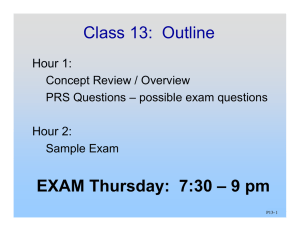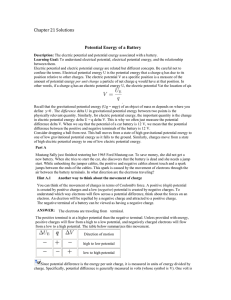77777 Instructor: Prof. Andrey Korytov, Prof. Paul Avery PHYSICS DEPARTMENT PHY 2054
advertisement
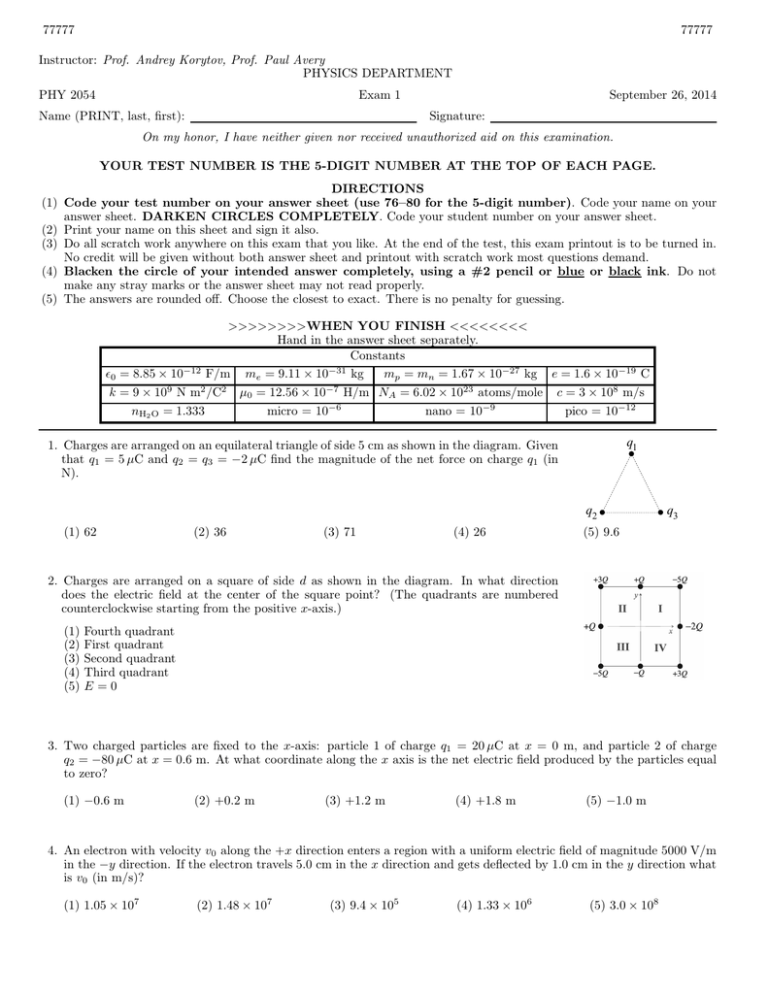
77777 77777 Instructor: Prof. Andrey Korytov, Prof. Paul Avery PHYSICS DEPARTMENT PHY 2054 Exam 1 September 26, 2014 Signature: Name (PRINT, last, first): On my honor, I have neither given nor received unauthorized aid on this examination. YOUR TEST NUMBER IS THE 5-DIGIT NUMBER AT THE TOP OF EACH PAGE. DIRECTIONS (1) Code your test number on your answer sheet (use 76–80 for the 5-digit number). Code your name on your answer sheet. DARKEN CIRCLES COMPLETELY. Code your student number on your answer sheet. (2) Print your name on this sheet and sign it also. (3) Do all scratch work anywhere on this exam that you like. At the end of the test, this exam printout is to be turned in. No credit will be given without both answer sheet and printout with scratch work most questions demand. (4) Blacken the circle of your intended answer completely, using a #2 pencil or blue or black ink. Do not make any stray marks or the answer sheet may not read properly. (5) The answers are rounded off. Choose the closest to exact. There is no penalty for guessing. >>>>>>>>WHEN YOU FINISH <<<<<<<< Hand in the answer sheet separately. Constants −12 −31 ǫ0 = 8.85 × 10 F/m me = 9.11 × 10 kg mp = mn = 1.67 × 10−27 kg e = 1.6 × 10−19 C k = 9 × 109 N m2 /C2 µ0 = 12.56 × 10−7 H/m NA = 6.02 × 1023 atoms/mole c = 3 × 108 m/s nH2 O = 1.333 micro = 10−6 nano = 10−9 pico = 10−12 q1 1. Charges are arranged on an equilateral triangle of side 5 cm as shown in the diagram. Given that q1 = 5 µC and q2 = q3 = −2 µC find the magnitude of the net force on charge q1 (in N). q2 (1) 62 (2) 36 (3) 71 (4) 26 q3 (5) 9.6 2. Charges are arranged on a square of side d as shown in the diagram. In what direction does the electric field at the center of the square point? (The quadrants are numbered counterclockwise starting from the positive x-axis.) (1) (2) (3) (4) (5) Fourth quadrant First quadrant Second quadrant Third quadrant E=0 3. Two charged particles are fixed to the x-axis: particle 1 of charge q1 = 20 µC at x = 0 m, and particle 2 of charge q2 = −80 µC at x = 0.6 m. At what coordinate along the x axis is the net electric field produced by the particles equal to zero? (1) −0.6 m (2) +0.2 m (3) +1.2 m (4) +1.8 m (5) −1.0 m 4. An electron with velocity v0 along the +x direction enters a region with a uniform electric field of magnitude 5000 V/m in the −y direction. If the electron travels 5.0 cm in the x direction and gets deflected by 1.0 cm in the y direction what is v0 (in m/s)? (1) 1.05 × 107 (2) 1.48 × 107 (3) 9.4 × 105 (4) 1.33 × 106 (5) 3.0 × 108 77777 77777 5. A conducting sphere with charge +10 nC is placed at the center of two concentric conducting spherical shells of radius r1 = 2 cm and r2 = 5 cm (measured to the outer surfaces). The inner shell carries a charge of −7 nC and the outer shell has a charge of +6 nC. Find the charge (in nC) on the inner surface of the outer shell. (1) −3 (2) +9 (3) +3 (4) −10 (5) +6 6. In the previous problem, find the magnitude of the electric field at r = 50 cm. (1) 324 V/m (2) 360 V/m (3) 830 V/m (4) 162 V/m (5) 0 V/m 7. Four charges of magnitude Q = 3.0 µC (but different signs, as in the figure) are arranged on the corners of a square of side 25 cm. Find the potential energy of the system of the four charges (in J). (1) −0.84 (2) −0.34 (3) +1.75 (4) +1.30 +Q -Q -Q +Q (5) 0 8. Electrons in a particle beam have a kinetic energy of 3.2 × 10−17 J. What is the magnitude of the electric field (in V/m) that will stop these electrons in a distance of 0.1 m? (1) 2000 (2) 1000 (3) 500 (4) 4000 (5) 200 9. The movement of a charge in an electric field from one point to another at constant speed without the expenditure of work by or against the field (1) (2) (3) (4) (5) none of these can only occur perpendicular to an equipotential can only occur along a field line only holds when the field lines are radial only occurs in a uniform field 10. Two particle each with with charge Q are fixed at the vertices of an equilateral triangle with sides of length a. The work required to move a particle with a charge q from the other vertex to the center of the line joining the fixed charges is a a a (1) 2kQq/a (2) kQq/a (3) kQq/a 2 (4) 0 √ (5) 2kQq/a 11. Two isolated conducting spheres are separated by a large distance. Sphere 1 has a radius of R and an initial charge 3Q while sphere 2 has a radius of 3R and an initial charge 7Q. A very thin copper wire is now connected to the spheres to allow charge to flow between the spheres. How much charge will be transferred from sphere 2 to sphere 1? (Note that the charge transferred can be positive, negative or zero.) (1) −Q/2 (2) +2Q (3) −Q/3 (4) +3Q (5) none of these 77777 77777 12. Four protons are placed at rest on the vertices of a square of side 2.0 µm. The protons are released simultaneously. When the protons are very far away, what is their speed (in m/s)? (1) 430 (2) 305 (3) 610 (4) 290 (5) 560 13. Two equipotential surfaces lying near the middle of the space between the plates of a parallel-plate capacitor are 2.0 mm apart and have a potential difference of 0.0012 volt. The area of each plate is 7.5 cm2 . What is the magnitude of the charge on each plate, (in units of 10−15 C)? (1) 4 (2) 16 (3) 5310 (4) 6.6 (5) 3320 14. A certain parallel plate capacitor with capacitance 12 µF is connected to a source of EMF with potential 3 V. A dielectric material with κ = 4 is then inserted between the plates of the capacitor with the capacitor still connected to the circuit. By how much does the energy stored in the capacitor change? (1) 1.6 × 10−4 J (2) 5.4 × 10−5 J (3) 1.2 × 10−5 J (4) 1.4 × 10−6 J (5) 0 J 15. An air-filled parallel-plate capacitor has a capacitance of 2 pF. The plate separation is then doubled and a wax dielectric is inserted, completely filling the space between the plates. As a result, the capacitance becomes 4 pF. The dielectric constant of the wax is: (1) 4.0 (2) 0.5 (3) 2.0 (4) 0.25 (5) 8.0 16. A parallel plate capacitor with a capacitance of 2.0 nF is charged to have 0.8 µC on each plate. How much work must be done by an external agent to double the plate separation while keeping the charge constant? (1) +1.6 × 10−4 J (2) −1.6 × 10−4 J (3) +8 × 10−5 J (4) −8 × 10−5 J (5) +2.0 × 10−4 J 17. A 9 V battery is connected to a 3 Ω resistor. How much charge passes through the resistor in 3 hours? (1) 32400 C (2) 540 C (3) 3600 C (4) 60 C (5) 13000 C 18. You have two resistors R1 and R2 , made from the same material, with the length and diameter of R1 both double that of R2 . If R1 and R2 are connected in parallel to a battery, find the ratio of the currents running through R1 and R2 (find I1 /I2 ). (1) 2 (2) 4 (3) 8 (4) 1 (5) 16 19. In the circuit diagram shown find the voltage drop across the 3.0 Ω resistor. 6.0 Ω 4.0 Ω 12 V 12 Ω 3.0 Ω (1) 4.5 V (2) 7.5 V (3) 9 V (4) 6 V 5.0 Ω (5) 1.5 V 77777 77777 20. In the circuit shown find the total energy (in µJ) stored on all the capacitors. Where C1 = 2 µF, C2 = 4 µF, C3 = 9 µF, C4 = 1 µF, C5 = 3 µF, and V = 10V. C2 V C1 C4 C3 (1) 182 (2) 364 (3) 36 (4) 18 (5) 950 C5
